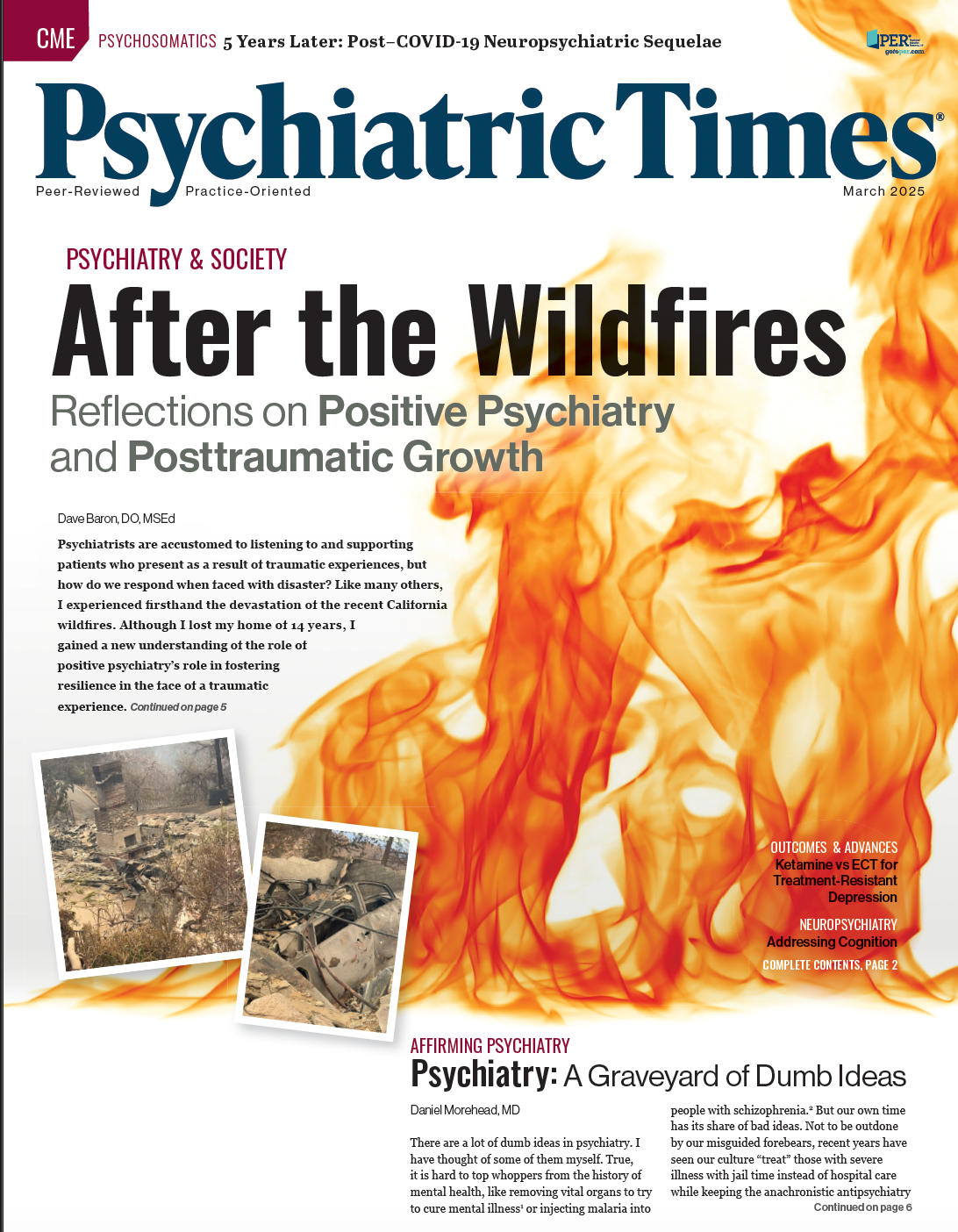
Publication
Article
Psychiatric Times
Experts Share Top 7 Recommendations for Treating Postpartum Depression
Author(s):
Key Takeaways
- PPD symptoms can emerge later than expected, complicating diagnosis and necessitating extended monitoring beyond the early postpartum period.
- Misunderstanding and stigma around PPD symptoms lead to delayed diagnoses; cultural competency and accessible screening are crucial.
- Routine screening for mood disorders should extend beyond the initial postpartum period, requiring multidisciplinary collaboration.
- Addressing sleep issues is vital, as sleep deprivation exacerbates PPD symptoms and impacts recovery.
- Zuranolone offers a promising treatment for PPD, with its fast-acting nature and short course appealing to patients wary of long-term medication.
A one-size-fits-all approach does not work—each mother’s experience with postpartum depression is unique.
BURINKUL/AdobeStock

“You can expect a little baby blues in some women for certain, but with postpartum depression, when a patient has persistent sadness, a loss of interest in pleasure, and anhedonia, and it is really affecting her quality of life…that is when I am going to start to really dig deeper into assessment tools,” said Deb York, MSN, PMHNP-BC, APRN, CCRA, in the recent Psychiatric Times custom video series Postpartum Depression (PPD) Patient Case Studies: Diagnostic Insights and Therapeutic Outcomes. York, a board-certified psychiatric mental health nurse practitioner (PMHNP) in Colorado who has been practicing since 2017, was joined in this conversation by Carmen Kosicek, MSN, PMHNP-BC, the CEO, founder, and a practicing PMHNP at Visionary Psychiatry in Oregon.
Together, York and Kosicek discussed 2 case examples of mothers experiencing PPD as well as shared insights and perspectives on how to provide the best possible care to this patient population. Here are the top 7 takeaways to come out of this discussion.
1. Postpartum Depression Can Appear Later Than Expected
Although traditional definitions of PPD define it as occurring within the first 12 months post partum, many women develop symptoms much later in the post partum period, sometimes around 8 months post partum or beyond. “I see patients who are fine until they are 8 months postpartum. Then, all of a sudden, boom. They are depressed, and they do not know why. They do not feel like they are a good mother, and they have guilt, massive anxiety, and depression. It is all over the board, and I cannot say that the definitions of PPD that we currently have are the most accurate all the time,” said York.
Clinicians should take note of this delayed onset, York and Kosicek explained, as it makes diagnosis harder, and many health care systems stop monitoring mothers after the early postpartum period. “I think that we have to broaden our scope of the term postpartum depression,” concluded York.
2. Symptoms Are Often Overlooked or Misunderstood
Many women experience guilt, anxiety, mood swings, and fatigue but do not recognize them as signs of PPD. Some assume these feelings are just part of adjusting to motherhood, leading to delayed or missed diagnoses. Severe cases may involve suicidal thoughts or intrusive fears about harming the baby, but stigma prevents them from seeking help.
“We must go forward with cultural competency,” said York. “Screening in accessible settings, telehealth, flexible outreach, affordable health care for everyone, promoting peer and support groups, and advocacy for policy change is really where we are going to see the biggest changes happen in the future.”
3. Lack of Routine Screening Leads to Missed Cases
Most mothers only have a 6-week postpartum checkup, after which the focus shifts to the baby’s health. York and Kosicek discussed how obstetrician-gynecologists (ob-gyns), midwives, and primary care providers need to improve long-term screening for mood disorders before, during, and after pregnancy. To achieve this, more multidisciplinary collaboration is needed between mental health professionals, ob-gyns, and primary care doctors.
“I am the patient’s primary go-to person,” said York. “But I also have their ob-gyn’s phone number. I like to collaborate with them and let them know again what the patient’s scores were before, during, and after pregnancy.”
4. Stigma Prevents Women From Seeking Help
Many mothers fear judgment if they admit they are struggling, leading to shame and silence. Some worry about being seen as “bad mothers” or even fear losing custody of their children if they disclose severe symptoms. Breaking the stigma around maternal mental health is crucial for early intervention.
“A lot of women discuss this feeling of ‘I am not a good enough mother and I am not doing enough,’ especially when they have other children. They feel like they are not doing a good enough job with the other children and now have the newborn baby. Some of these women have deep dread and deep ideations of self-harm because they are not doing a good enough job,” said York.
5. A More Holistic Approach to Maternal Mental Health Is Needed
A one-size-fits-all approach does not work—each mother’s experience with PPD is unique. Kosicek and York emphasized the need for expanded postpartum care, including the following: (1) better education for mothers about PPD signs and symptoms; (2) screening for mental health issues during pregnancy, not just after birth; and (3) more support systems like therapy, peer support, and medication when needed. “Community assistance and community health is so needed,” emphasized York.
6. Addressing Sleep Issues Should Be a Priority
“Restorative sleep is just fundamental to PPD, depression, recovery, and the worsening of depression. Symptoms happen with the lack of sleep. Sleep loss is associated with heightened anxiety and comorbidities, physical exhaustion, and an increase in suicidal ideation in PPD,” York shared. “Sleep is primal, whether you are pregnant, just had a baby, or not. We have to have sleep.”
Mothers may want to avoid taking sleep medication because they fear they will not hear the baby crying or they do not want to miss a feeding, York added. “There is a lot of regulation and scheduling to get sorted out between when the baby eats and when the baby sleeps, and to get your sleep when the baby sleeps. It is really difficult.”
Kosicek echoed this sentiment: “Not everybody will look at options for sleep because patients do not want to sleep through things. But we must really teach them how short-term sleep might need to be different within the family, even if they have someone in their world who can come over and help them so that they can get a good 5 or 6 hours of short-term sleep. It is that perpetual lack of sleep that further fuels this fire of PPD.” Both clinicians recommended reducing noise and light, practicing nighttime sleep hygiene, getting off devices earlier, and even charging cell phones in the kitchen to reduce distraction—all to encourage better, restorative sleep.
7. Talk to Patients About Utilizing Oral Medication
Kosicek and York emphasized the importance of discussing zuranolone—the first oral medication indicated to treat PPD—with patients as a treatment option, as faster-acting treatments might improve patient outcomes and quality of life. “Now we have medications to truly treat and address PPD,” said Kosicek. “It is amazing that in this day and age, we finally have a drug approved and on the market.”
In terms of recommendations for initiating a conversation with patients about zuranolone, Kosicek and York recommend sharing that there is a first-in-class drug approved for PPD that has a 2-week course. The latter detail may be of special interest to patients, as they frequently do not want to stay on medications long-term, in what Kosicek dubbed “one of the biggest challenges in psychiatric medicine.” If patients are already taking a selective serotonin reuptake inhibitor (SSRI), Kosicek and York suggest allowing the patient to decide whether to continue taking it, as they may be attached to their SSRI. If a patient is unsure, they can be weaned off their SSRI over time. When assessing for treatment success, Kosicek and York look for better sleep and a drop in urgency of symptoms like anxiety and guilt.
“Within 3 to 5 days, they are feeling so much better. Their apathy lifts, they have more energy, they have better sleep, and just their whole quality of life is starting to improve. That is when they perk up and are interested in learning a whole lot more about this medication,” said Kosicek. “I think a lot of our colleagues have not yet had the opportunity to understand how to prescribe zuranolone. Zuranolone itself is truly the fastest acting option for what many have previously thought only possible with an SSRI.”
Additionally, Kosicek reminded clinicians of the availability of medications like zuranolone, particularly for mothers in vulnerable groups: “In underserved communities, I think the biggest thing that we all need to remember is, there is access to these newer meds whether the coverage is commercial, Medicaid, or Medicare. It is there for our whole community. Keep spreading the word that there are FDA-approved medications for PPD so that all women know what is truly available.”
Also important to remember is that clinicians should check in with patients when they initiate zuranolone, York shared, particularly a week after they first begin taking the medication. “I keep a very close eye on my patients with PPD. When they start treatment, depending on when they get it shipped to their home, I will have them send me a message detailing when they initiated it and how they are doing. Then I will either do a telehealth call with them within a week or they can come to the office—it is totally up to them. Then I follow up again the week after they are done with the medication to see how they are feeling,” York said. “Sometimes I will even give patients my cell phone number if I am really concerned about them, or I will give their primary caregiver my number in the event they need anything immediately.”
Concluding Thoughts
In concluding their discussion, the duo agreed that clinicians must do more to spread education about the postpartum period to improve patient outcomes.
To watch this Case-Based Psych Perspectives program, visit psychiatrictimes.com/view/overview-of-ppd-and-current-management-practices
EP: 1.Overview of PPD and Current Management Practices
EP: 2.New FDA-Approved Treatments for PPD
EP: 3.The Case of a 34-Year-Old Woman With PPD After the Birth of her Third Child
EP: 4.Diagnostic Tools for PPD
EP: 5.Treatment Choices For PPD and Peripartum Depression
EP: 6.Monitoring Treatment Response and Challenges in Managing PPD Patients in Ob/Gyn Practices
EP: 7.A Case of PPD in a Mother With a History of Major Depressive Disorder
EP: 8.Assessing Symptoms, Treatment Decision-Making, and Monitoring
EP: 9.Supporting Mothers With Postpartum Depression and Promoting Culturally Sensitive Care
EP: 10.Experts Share Top 7 Recommendations for Treating Postpartum Depression

2 Commerce Drive
Cranbury, NJ 08512
All rights reserved.




